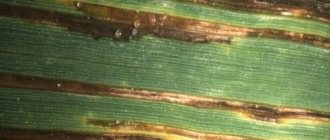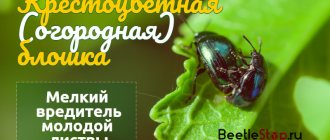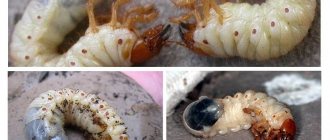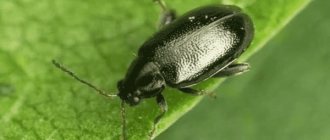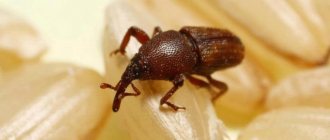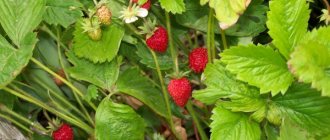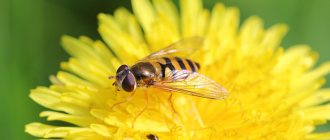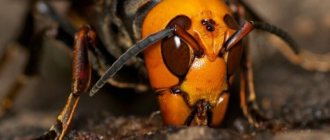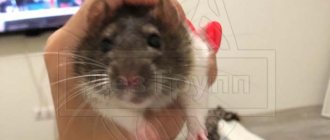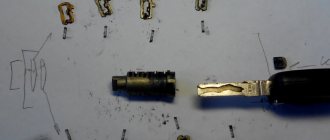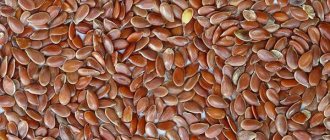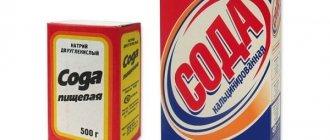Agricultural producers in all agricultural regions of Russia suffer from hordes of harmful insects every summer. In 2022, the most complaints are about the pest bug, which spoils grain crops, the cotton bollworm, which affects sunflowers and corn, and the striped flea beetle, a pest of cereal crops.
Life cycle
The striped bread midge overwinters in the soil, in fences, on roadsides or the edges of forests.
The beetles overwinter in the top 5 cm of soil. They appear when the soil temperature reaches 18° C. The first peak of activity occurs at the end of June. Flea beetles become active in early spring when temperatures warm up to 20°C, although they can be seen on warm days in winter. Corn is the primary host of striped bread flea beetle, but adults and larvae also feed on several secondary hosts such as orchard grass, foxtail grass, fall broom, and some other grasses. Wheat, barley, and oats have also been identified as food plants for these fleas. In the spring, adult beetles feed on corn and other hosts, mate, and lay eggs on plant leaves, in the soil, or at the base of plants near underground stems and roots.
The larvae hatch from eggs laid in the soil and feed for 2-3 weeks. After pupating in the soil, they emerge as adults to repeat the life cycle. There are from one to four generations per year. The generation time of the striped flea beetle is approximately one month. However, higher temperatures lead to faster development rates. The larvae complete their development, pupate, and adult fleas emerge in June.
The adults continue to feed on available host plants and lay eggs for another generation. Second generation adults emerge in early August and feed until late autumn before wintering.
Folk remedies for removing fleas
Folk remedies are most effective at the very beginning of the pest growing season, as they help prevent a massive infestation of fleas. They can also be used in cases where pest numbers are low.
How to fight fleas on cabbage using anti-flea shampoo, learn from the video:
Ash dusting
Experienced vegetable growers have noticed that flea beetles do not settle in areas dusted with wood ash. It is laid out in each hole when planting cabbage seedlings in a permanent place, and then it is also sprinkled between rows after planting is completed.
To prevent the leaves from being to the taste of the bugs, they are treated:
- tobacco dust;
- a mixture of stove ash and slaked lime (fluff).
Spraying with infusions and solutions
To get rid of cruciferous flea beetles, cabbage can be sprayed with various means. The following recipes have worked well:
- Tomato-garlic infusion. 250 g of fresh tomato tops are crushed, and 10 garlic heads are passed through a meat grinder or garlic press. Plant components are poured into 10 liters of warm water and infused throughout the day. Next, the infusion is filtered and 50 ml of liquid soap is dissolved in it for better adhesion of the liquid to the leaf plate.
- Dandelion infusion. 500 g of fresh dandelion leaves and flowers are crushed and poured into 10 liters of water. Leave for 3 days, then filter and add 50 ml of liquid soap.
- Ash-soap solution. 1 g of crushed ash is poured into 3 liters of boiling water and left to infuse for 2 days. Then add 1/4 of a bar of soap to this mixture - laundry, green potassium or tar.
- Infusion of chicken manure. Chicken manure is diluted in water in a ratio of 1:20. Leave the mixture to ferment in the open air and use it for its intended purpose.
- Tobacco infusion. It is prepared from 200 g of tobacco and 10 liters of water with the addition of a small amount of soap.
- Infusion of wormwood. 1 kg of fresh plant material is crushed and 10 liters of boiling water is poured. Infuse it for one day, covering the container with a lid.
Video about simple and reliable means of combating cruciferous flea beetles:
Using adhesive tape
This method helps reduce the number of pests. To do this, a layer of some sticky compound - resin, tar or natural honey - is applied to thick cardboard or plywood on both sides.
Then, waving this device, they walk several times along the rows. Disturbed fleas begin to jump and stick to the sticky layer. After the procedure, the cardboard with insects stuck to it is burned.
Using motor oil
Some vegetable growers, who also happen to be car owners, have noticed that flea beetles are attracted to the smell of used motor oil. So, in order to remove some of the pests from the cabbage, you can place rags well soaked in oil on the garden bed at a distance of 3-4 m.
Symptoms
Most often you can see holes in the leaves, especially on young seedlings, where damage occurs most quickly and causes the most damage. The holes they make are round and can quickly damage young greenery. New leaves are usually the first to be damaged and have a lacy appearance. Damage also appears as scratches on the upper and lower surfaces of the leaf, usually parallel to the veins. They feed on both the upper and lower epidermis of corn leaves, but do not chew them completely.
How to fight?
Methods of bean pest control include proper preparation of the harvested crop for storage and ensuring the correct conditions for the preservation of beans. To do this, you need to know the optimal temperature, humidity level, and method of calcining the beans.
What to do if bugs are already infested in the crop? Unfortunately, such a product becomes unsuitable for consumption and further planting, so it must be thrown away.
To prevent crop contamination, you need to know the rules for controlling major pests. You can cope with bean weevil by treating the plants with Metafox and Decis before flowering. Repeated treatment is done 10 days after the first.
If previous plants were affected by the sprout fly, next time it is necessary to perform the following preparatory steps:
- remove all weeds from the site;
- organize sowing in the early period: at a soil temperature of 10 degrees;
- if manure is used, it must be buried in the soil;
- Before sowing, grains must be soaked in a growth stimulator.
To protect plants from slugs, the soil around the planting should be covered with dry nettle stems. They will scare away pests and the harvest will be preserved.
To combat aphids, you need to spray the plants with a soap solution. You should also water the plantings with fertilizer made from nettles.
Harm caused
Flea beetles usually do not cause fatal damage to host plants because the leaves are large enough. The real danger is that they can spread bacterial diseases such as wilt from plant to plant. Therefore, they must be destroyed immediately.
Little is known about the damage caused by the larvae, but damage from adult striped bread flea beetles is very obvious. High density and intensive feeding can lead to skeletonization of leaves and death of seedlings. The leaves of severely damaged plants appear whitish or silvery. During June and August, when newly emerged adults emerge, corn leaves may be partially scarred as they feed.
The adult beetle damages plants by removing leaf tissue and transmitting pathogenic bacteria that accumulate in the plant's vascular system and clog it, affecting the movement of water and nutrients. Some plants become infected at the seedling stage, while others do not become infected until tassels appear or even later.
Typically, field corn infected with wilt (Stuart's disease) will show few signs of disease until late summer, when numerous lesions will appear on the leaves. In years when flea beetles are abundant and the disease is widespread, some corn varieties wilt and the plants may die before tasseling. Drought can aggravate the disease state of the plant. When conditions are favorable for both beetles and wilt, nearly 100 percent of susceptible field corn varieties will show symptoms of Stewart's disease by late fall.
Sweet corn plants that are infected early are usually the most severely affected. Young plants usually wilt, become stunted and have water-soaked lesions with wavy edges.
Like many insects, the winter survival of the striped bread flea beetle depends on the severity of winter. Mild winters improve the survival rate of the pest.
Trap for horse flies and gadflies from BioTrap
Today, on the Internet and in specialized stores, you can easily buy ready-made traps for these flying insects. At the same time, the most popular model is produced.
The design of this trap takes into account the behavioral characteristics of horseflies and gadflies, their biology - how they fly and hunt. Due to this, it turns out to be very effective. The trap consists of:
- special bait (including visual decoys, attractant, heat source);
- cone-shaped retaining mesh;
- catching device;
- metal frame with tripod structure.
The principle of operation of the trap is as follows:
- Gadflies and horse flies are attracted to a ball heated by the sun, which reminds these insects of a large animal. In addition, it is treated with a special attractant.
- Having sat on the ball, at some point the gadfly or horsefly decides to take off. He almost always does this vertically upward.
- As a result, the insect ends up under the dome, and from there into a trap container, from which it can no longer escape.
Note that using a trap for gadflies and horseflies from the Biotrap brand is as simple as possible. In addition, it is economical and 100% safe and harmless to humans and animals. After all, when using it, you do not need to use any chemicals or electricity.
Where can the BioTrap be used? This:
- pastures;
- livestock farms;
- summer cottages and garden plots;
- horse clubs;
- fields for sports;
- local areas;
- beaches, etc.
According to numerous tests and reviews, one such trap is enough to significantly reduce the number of gadflies and horseflies in an area of up to 1 hectare. With its help, you can get rid of dozens, or even hundreds of insects in literally a matter of hours.
The only caveat is that the cost is not the lowest. Therefore, many craftsmen try to make traps themselves with their own hands, taking the design features of the product as a basis.
Prevention
Because striped bread flea beetles are aggressive pests that can devastate crops in a short period of time, early detection is the best defense, especially if conditions favor the survival of adults.
Increasing the area under crops can help reduce the impact of striped flea beetles. For a pest population, having more plants per unit area means that the damage it causes per plant is reduced and seedlings can more easily recover from injury.
Limit their food supply by delaying transplanting or planting for a couple of weeks if possible.
Covering seedlings with special fiber can protect plants from these pests. It should be used immediately after transplantation so that pests do not have time to infect the plant.
Striped bread fleas cannot tolerate the smell of mint and basil. They are attracted to nasturtiums and radishes. You can plant them as flea traps to prevent them from attacking other more valuable plants.
Conditions that may indicate a high risk of infection:
- Warm, humid days in April and early May promote egg survival.
- Sunny weather and dry conditions after sowing make the beetles more active.
- Soil that warms up quickly on sunny days.
Effective chemicals
In the fight against cabbage flea beetle, the following insecticidal preparations are most popular among summer residents:
- Aktara. This is a systemic insecticidal preparation of contact-intestinal action that can cope with a large number of different harmful insects, including secretive and sucking insects.
- Actellik. Organophosphorus non-systemic insectoacaricidal preparation of contact-intestinal action, which is used in the fight against leaf-eating and sucking harmful insects.
- Karate. A contact-system combined insecticidal agent used to control sucking and gnawing pests.
- Bankol. This is an insecticidal preparation of contact-intestinal action that destroys sucking and gnawing harmful insects.
- Decis. A broad-spectrum contact-intestinal insecticide from the pyrethroid group. It effectively fights lepidopteran, coleopteran and homoptera harmful insects.
In addition to these drugs, you can use Inta-Vir, Mospilan, Fitoverm and others with similar effects.
Watch this video on YouTube
Description of cereal crops and their importance for humans
The fruit of cereal plants is a monocotyledonous grain seed fused with a shell. The leaves are long, with parallel veins, narrow, two rows. The stem is hollow and thin. Usually long. Inflorescences are paniculate, spikelet or racemose.
Cultivated cereals
Over time, people realized that not all grains are edible and suitable for cooking. They were looking only for those whose grains made tasty food. That is, cultivated cereals were needed. The person also realized that it is not necessary to collect something somewhere.
Look for suitable plants, go around every time and find out where they grow and in what quantities. Then take the seeds, take them home, and so on in a circle. After all, you can start growing cereal plants not far from your own home. Plant the fruits, water them and wait for them to sprout, grow into plants and ripen.
New fruits were collected, some were left for grinding, and some were left for the next sowing. This is how agriculture developed. New varieties of cereals were developed, which should be resistant to droughts and other negative influences. Breeders took into account the flower formula of cereals in order to predict the genetic structure of new plants and create a similar formula.
Morphology
Imago
The beetle is 1.6–3 mm long and 0.9–1.3 mm wide. The covers are dark bronze in color, often with a greenish tint, sometimes dark blue, golden, copper, less often greenish-bronze, slightly shiny. The main part of the antennae and legs are reddish-yellow. The fore and middle femora are reddish-brown with a bronze sheen, translucent. Hind thighs bronze.
The body is oblong-ovate, convex. The spaces between the points on the head and pronotum are equal to the points themselves.
Larva
Light gray, head and body sclerites dark brown, legs dirty brown. The body shape is elongated, cylindrical with narrower posterior and anterior ends. Length at the end of development is 5 mm. The last abdominal segment has a chitinized tooth.
Morphologically related species
In terms of the morphology (appearance) of the imago, the large flea beetle (Chaetocnema aridula) is close to the described species. The main differences: the base of the antennae from below, the tibia and tarsi are brown. The elytra have small, dense, tangled punctures inside.
Due to the similarity of species in morphology and biology, some authors combine the Large flea beetle and the Stem flea beetle into one species.
In addition to the indicated species, Chaetocnema sahlbergi is often found, also similar in adult morphology to the Stem flea beetle (Chaetocnema hortensis).
Geographical distribution
Distributed in the European part of Russia, the Caucasus, Kazakhstan, Central Asia, and Siberia. The pest's range covers Western Europe, Central Asia, and Eastern China.
Maliciousness
The stem flea beetle greatly harms cereals at the larval stage. Adults damage beet seedlings.
The most harmful are the larvae. As a result of the damage caused, first the central leaf wilts and turns yellow, and then the entire stem of the cereal. When emerging from the stem, the larva forms a characteristic, clearly visible exit hole at the base. This hole distinguishes cereals damaged by the stem flea beetle from plants damaged by the Swedish fly (Oscinella pusilla).
Plants are damaged during the tillering, booting and heading phases. Stems damaged before heading stop growing, the ear remains in the leaf axil. Damage in the heading phase is caused by white ear and stem lodging.
The economic threshold of harmfulness is determined in the tillering phase and is 30 beetles per 100 sweeps of the net or 10% of damaged stems.
What other types of traps are there?
Traps for horseflies and gadflies may differ, but the essence of the trapping method remains the same. The cost of homemade structures is very low. Now you can buy various models of industrial production. They are sold in specialized stores. The most popular is produced.
At one time, a device invented by the scientist K.V. Skufin for similar purposes became widespread. Outwardly, it resembles a cow. A rectangular wooden frame stands on four legs. It is covered with a dark cloth on top, in the center of which you need to cut a hole. A cage made of wire covered with gauze is attached to it.
A natural and inexpensive remedy for aphids, slugs, caterpillars and ants. Mustard is widely used on the farm. This product is useful both in everyday life and in growing plants. He helps…
Victory in the fight against annoying flying enemies is worth the time and effort. The described technique is safe, economical and easy to use. Practice has long proven that it really works and makes the life of gardeners easier.
Pesticide Information
Drug: the name of the pesticide, its formulation, content of active substance, registrant, state registration number, restrictions and expiration date of registration are indicated. Numerical designations separated by fractions from (1) to (4) after the registrant indicate the hazard classes of the drugs. The numerator is the hazard class for humans, the denominator is for bees in field conditions. (P) - prohibition of use in the sanitary zone around fishery reservoirs at a distance of 500 m from the flood line at the maximum standing of flood waters, but not closer than 2 km from the existing banks . For pesticides intended for pre-sowing treatment of seeds, it is prohibited to treat seeds in the specified zone; sowing of treated seeds is permitted.
Application rate: the application rates for pesticides are indicated (by preparation): for solid formulations – in kg/ha (for seed protectants – in kg/t), for liquid formulations – in l/ha (for seed protectants – in l/t ). In other cases, application rates given in other units of measurement are indicated next to the numerical value of the pesticide application rate. The application rates for herbicides are given based on continuous tillage; with the belt application method, the application rate is reduced in proportion to the decrease in the cultivated area. (A) - permission for aerial treatments in these application regulations. (L) - permission to use the drug on private farms. Regulations for the use of the drug on private farms are presented in a separate line.
Culture: Cultures are indicated. Two crops, for example, tomato and cucumber, are indicated for both open and protected ground, unless specifically stated.
Harmful object: harmful objects against which this pesticide is recommended are indicated; for desiccants and plant growth regulators - the purpose of the drug.
Method, processing time, application features: the method, processing time, application features are posted. The expression “Consumption – 400 l/ha”, “Consumption – 12 l/t”, etc. means the flow rate of the working fluid (solution, emulsion or suspension), unless “Working fluid flow rate” is indicated.
Waiting period (number of treatments): waiting times are indicated, with the number of treatments in parentheses. The waiting period is the time interval between treatment with the drug and harvesting, indicated in days. If the use of a pesticide is clearly one-time, for example, pre-sowing seed treatment, then a dash (-) or (1) may be indicated in the sixth column.
Time limits for manual (mechanized) work: the time for people to enter areas treated with pesticides to carry out manual (mechanized) work to care for plants is given in days.
Protection system for table, sugar and fodder beets
The protection system for table, sugar and fodder beets consists of the following agricultural practices performed at different periods.
Pre-sowing period. Compliance with reasonable crop rotations (4-5 years). The best predecessors are winter cereals (wheat, rye) and spring cereals (oats, barley), peas, corn for silage and a layer of perennial grasses. To combat beet pests and diseases, spatial isolation of crops from last year's beetroots and planting of seed root crops is necessary. Fertilizers are applied in calculated doses to increase resistance to root beetles, cercospora blight, and pine rot. Phosphorus weakens the development of root rot, potassium - cercospora blight, boron - heart rot, manganese and boron - cercospora and root blight. In the fall, stubble is peeled, deep autumn plowing is carried out, and in the spring, moisture is closed and pre-sowing treatment is carried out, ensuring a fine-lumpy soil condition. It is necessary to select, sort and calibrate seeds. Another way to combat beet pests and diseases is to disinfect seeds with fungicides: TMTD, tachigaren, Apron XL, Maxim, etc. Seeds are also treated in advance with protective and stimulating substances. Treatment of beet seeds with insecticidal preparations to protect seedlings and seedlings from soil-dwelling pests (wireworms, false wireworms, gnawing armyworms) and from early ground pests (flea beetles, weevils, sand worms, etc.).
Sowing period. Sowing beets at optimally early dates in well-prepared soil to ensure vigorous and well-developed seedlings by the time pests appear. To protect sugar and other beets from diseases and pests, seeds are sown in heated soil at an optimal depth of 3-5 cm. During seed germination, it is necessary to maintain the soil surface in a loosened state by carrying out pre-emergence and post-emergence harrowing.
Growing season. During the period of emergence of seedlings until the development of 2-3 pairs of true leaves, if necessary, marginal or continuous treatment of crops with insecticides against flea beetles and weevils is carried out. In the phase of 2-3 pairs of leaves, treatment is carried out at a high infestation of beet leaf miner. Disease-affected plants are removed from seed crops. When affected by diseases, beet crops are sprayed with 1% Bordeaux mixture for treatment; copper oxychloride; Bayleton; colloidal sulfur; cuproxate; quadris; falcon; folio, etc. The use of biological products Alirin-B and Gamair is effective. They are treated with insecticides against viral vectors. During the period of closure of plants in rows and later at high numbers, insecticides are sprayed against beet leaf aphids, beet bugs, caterpillars of polyphagous lepidoptera: meadow moth, gamma cutworm, etc. During the growing season, inter-row cultivation of the soil is carried out to destroy the soil-dwelling stages of the pest - larvae and pupae weevils, beet flies, meadow moths, cutworms.
Harvest period. Before harvesting royal beets, areas in which the plants are affected by downy mildew exceeds 5% are rejected. Clean harvesting of beets with removal and destruction of post-harvest residues. Subsequent deep plowing of the soil. Before storing root crops, a thorough sorting is carried out, all damaged, frostbitten, wilted and with signs of rotting are discarded.
Photos and names of cereal herbs
Cereal herbs can become a decoration for our summer cottages if we learn how to use them correctly.
Major pests
The greatest damage to crops is caused by Swedish flies, ear flies, winter flies, Hessian flies, common leopards, large cereal aphids, ground beetles, sawflies, bread bugs, fall armyworms, greeneyes, and wheat thrips. Not least among the pests are representatives of the order of rodents: gophers and mouse-like rodents.
Nature of the harm caused
Insects harm plants at different stages of development. In various species of flies and sawflies these are larvae. They eat young leaves, flowers, ear buds, and tillering nodes from the inside. As a result, plants stop growing and do not reach the fruiting phase.
Pests such as the beetle, large cereal aphids, thrips, and breadbugs cause damage to the phytomass of wheat both in the larval and adult stages. In addition, the stems of winter wheat plants are the overwintering site for thrips and some orthoptera (greeneyes, Swedish flies).
Mouse-like rodents and gophers damage crops by digging up and eating sprouted seeds, which causes thinning of seedlings. At the stage of milky ripeness of wheat, animals bite off young spikelets.
Control and prevention measures
The best results in controlling winter wheat pests are achieved by a set of measures. It includes agrotechnical, biological and chemical methods.
Agrotechnical techniques
- Harvesting grain as quickly and as early as possible.
- Timely plowing of the land and weed control.
- Compliance with crop rotation rules. Winter wheat is not recommended to be sown in fields after cereal crops.
- Moderately late sowing.
- Removing plant residues from fields after harvest.
- Using varieties that are resistant to pests.
Biological techniques
Trichogramma plants are used as biological control. Their larvae parasitize the eggs of Lepidoptera and Homoptera. In addition, most insect pests have other natural enemies that can be exploited in agricultural areas. These include predatory ground beetles, lacewings, tahini, aleohara beetles, ascogaster beetles, ladybugs and others.
Beneficial properties of barley
Barley is rich in polysaccharides, proteins, vitamins A, B, D, E and PP, as well as minerals: calcium, phosphorus, potassium, iodine, iron, copper, magnesium, cobalt and many others. Thanks to such a rich content of nutrients, barley has a healing effect on the body:
- – improves metabolism;
- – increases brain performance;
- – lowers blood cholesterol levels;
- – helps cleanse the body of toxins;
- – strengthens the immune system;
- – strengthens bones, cartilage, teeth and nails;
- – makes the skin firm and elastic;
- – slows down aging.
